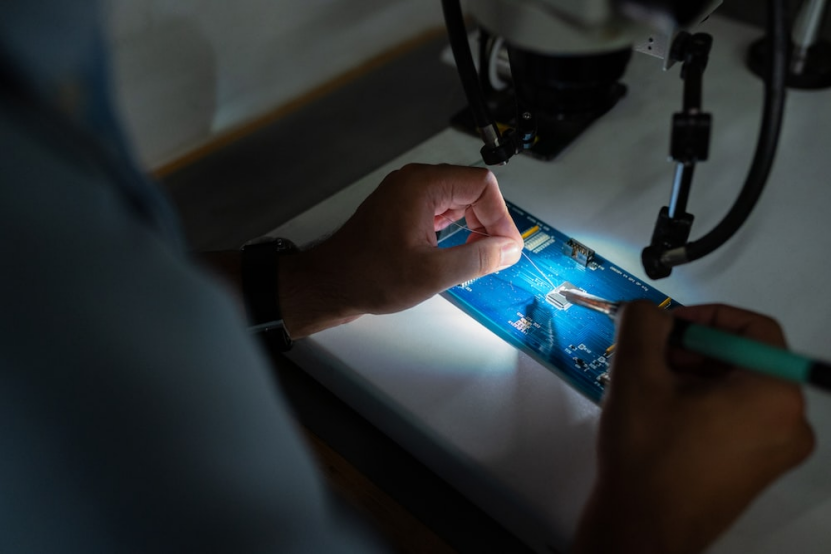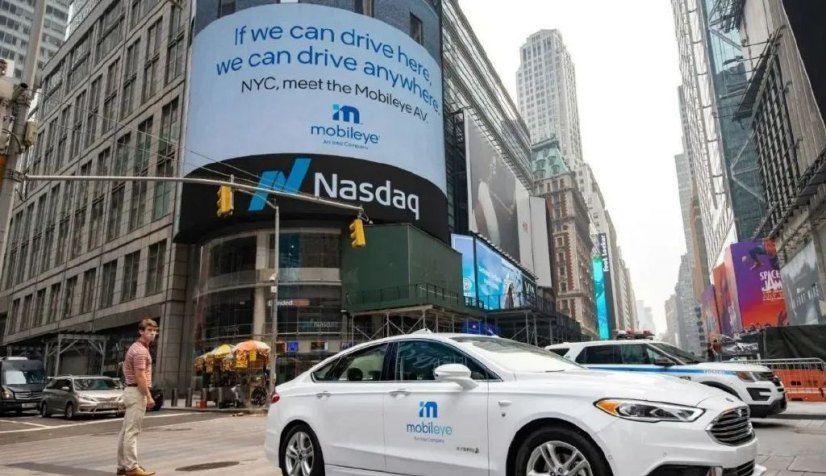Mobileye Goes Public on NASDAQ, with a Closing Market Value of USD 23 Billion
Authored by: Sun Mingzhi
Edited by: Wu Xianzhi
On October 26, 2022, Mobileye went public on NASDAQ with a closing market value of USD 23 billion. The IPO was priced at USD 21 per share, raising a total of USD 861 million, ranking the fourth highest among all US IPOs this year.
The last time Mobileye made a big splash worldwide was in March 2017 when Intel acquired it for USD 63.54 per share in cash, with a total equity value of approximately USD 15.3 billion, amidst rumors that it was valued at USD 50 billion.
Founded in 1999, Mobileye is an Israeli company that produces visual systems to assist drivers in ensuring passenger safety and reducing traffic accidents, focusing on the Advanced Driving Assistance Systems (ADAS) field.
In the field of autonomous driving, Mobileye is an absolute “giant”. Data shows that by the end of 2019, Mobileye’s market share in the ADAS field was around 70%.
However, in the past two years, the development of high-performance autonomous driving chips has “taken a high-speed train”, bringing a significant challenge to the once dominant autonomous driving technology.The competitiveness of Mobileye’s competitors, including NVIDIA, Horizon, Huawei, and others, in the field of autonomous driving is very strong. Many car manufacturers are also researching or using autonomous driving chip products and services outside of Mobileye. In mid-July 2016, Mobileye terminated its partnership with Tesla, leading to Tesla’s use of FSD and its own research on chips.
Most domestic and foreign car companies that produce large quantities of advanced driver assistance and autonomous driving systems initially relied on chips from companies such as Mobileye and NVIDIA. However, since last year, this situation is quietly changing. Qualcomm has entered a strong position. Chinese manufacturers like Huawei, Horizon, and Black Sesame Intelligence are also emerging in the autonomous driving chip market and gradually joining the competition with NVIDIA, Qualcomm, and other large-scale computing chip companies.
At present, except for Xpeng, which still uses Mobileye, almost all high-end electric vehicle models in China have invested in chips from manufacturers such as NVIDIA, Qualcomm, and Huawei.
Look at Mobileye’s slogan at the time: “If we can drive here, we can drive anywhere.” What a great ambition.
Although Mobileye was once the king, with an impressive record of selling 100 million chips, the challenge of losing car orders is even greater than the shrinkage of its valuation.
Let’s take a look at some examples of starting anew:Ideal L8 and Ideal L7 are two new cars, and the Pro version is equipped with the Horizon Journey 5 chip. In 2021, the Ideal ONE was equipped with two Horizon Journey 3 chips instead of the original Mobileye Q4 chip for its advanced driving assistance system. With the existing L2 level advanced driving assistance system, it now also has the NOA navigation assistant driving function.
The MAX versions of Ideal L7, L8 and L9 are equipped with two Qualcomm Snapdragon 8155 chips, and a computing platform composed of 24GB of memory and 256GB of high-speed storage to provide computing power for AI, software and entertainment. The 8155 chip adopts an 8-core design, and can support up to 6 cameras, connect 4 2K screens or 3 4K screens, support WiFi6, and support 5G and Bluetooth 5.0. In addition, the SA8155P is also a 7nm process automotive cockpit SoC chip, which has stronger power management.
NIO once used Mobileye EyeQ4 chip on ES8, but switched to NVIDIA later because the computing power of the chip did not meet expectations. NIO ET7 is equipped with four NVIDIA Drive Orin chips, making it the world’s first mass-produced car equipped with NVIDIA Drive Orin (48 CPU cores, 256 matrix computing units, 8096 floating-point computing units, totaling 68 billion transistors).
JAC Motors has chosen Black Sesame Technologies, and several models will be launched soon.The more vivid example is that BMW, a long-term partner of the company, announced at the beginning of 2022 that the next-generation ADAS computing hardware will be replaced by Qualcomm’s SnapdragonRide platform. The core of the Qualcomm Snapdragon Ride platform consists of two chips: SM8540 and SA 9000B accelerator. The AI computing power of a single board is 360TOPS, and the overall power consumption is 65 watts, with 5.5TOPS/W. The AI computing power of four accelerators can reach a total of 1440TOPS by adding four sets of computing platforms through the PCIe switch.
As more car companies move towards L3 or even L4 level autonomous driving technology, Mobileye needs to reorganize and provide competitive new products. Mobileye had gradually “withdrawn” from this era right after going public.
Driven by the high enthusiasm of domestic capital and strong government policies, domestic chip manufacturers have ushered in more opportunities. Once missed, it will be much more difficult to catch up with other companies. Against this background, the speed of domestic chip-making has been upgraded again.

Horizon
Horizon is one of the earliest domestic chip manufacturers to layout self-driving chips, and has been focusing on AI chips since its establishment in 2015. It has now achieved mass production on chips installed on vehicles.
Journey 5 is the third-generation vehicle-grade product after Journey 2 and Journey 3 mass-produced Chinese AI chips. It has both high computing power and high performance, and a single chip can reach a maximum of 128 TOPS of AI computing power, supporting 16-camera perception computing. It has millisecond-level efficient collaboration, and can support the needs of autonomous driving such as multi-sensor fusion, prediction, and planning control.
HuaweiThe MDC 810, released in July 2021, has a computing power of 400+TOPS and supports Robotaxi L4-L5 autonomous driving, bringing Huawei’s MDC product line to cover all levels of autonomous driving from L2 to L5.
Black Sesame
Founded in 2016, Black Sesame is a high-performance autonomous driving computing chip provider, which has received strategic investment from Xiaomi’s Changjiang Industry Fund and completed two rounds of financing in Series C in September 2021.
Currently, Black Sesame has launched three autonomous driving chips, with A1000 chip as its flagship product. The A1000 chip has a computing power of 58TOPS, an 8-core high-performance ARM Cortex A55 CPU with a frequency of 1.5GHz, and a typical power consumption of 18W for the entire chip. It can cover all types of autonomous driving vehicles from L2 to L4.
Cambricon
Established in 2021, Cambricon is committed to building a world-class intelligent driving chip and solution provider with high performance and reliability, providing strong “core” support for “software-defined cars”, and creating a worry-free and confident driving experience for global automotive industry customers.
Next year, Cambricon will release the first 7nm domestic chip platform SD5226 with a computing power of over 400TOPS, CPU computing power exceeding 300KDMIPS, covering L4 autonomous driving vehicles.
QualcommIn early 2020, Qualcomm launched Snapdragon Ride, a computing system for autonomous driving, which consists of an ADAS safety system-level SoC, a dedicated accelerator chip ASIC for autonomous driving, and an autonomous driving software stack. The SoC chip adopts 5nm process technology with a computing power of 30TOPS, which can meet the needs of autonomous driving applications above L2 level. By combining different numbers of SoC chips and ASIC chips, the Snapdragon Ride computing system will form different computing power, achieving a maximum computing power of 700TOPS (power consumption of 130W) to meet the computing needs of higher-level autonomous driving.
In addition to the ideal concept car mentioned above, there are many other vehicles that use Qualcomm chips, all of which are equipped with the Snapdragon 8155 chip. These include traditional car manufacturers’ models like SAIC IM L7, JiKe 001, Voyah Dreamer, Voyah Free, and GAC Aion LX Plus.
New car companies’ models include the NIO ES8, NIO ES6, Xpeng P5, Leapmotor C11, and WM Motor W6.

Just recently, the autonomous driving startup Argo AI announced that it would be closing its business. Jim Farley, CEO of Ford Motor Company, stated in a statement on October 26th that “there is still a long way to go to achieve large-scale, profitable fully autonomous vehicles, and we don’t necessarily have to develop this technology ourselves.”It’s clear that Ford doesn’t intend to develop autonomous driving technology on its own, while Volkswagen plans to focus on cooperation with other companies, such as the collaboration between Bosch and Horizon Robotics. This is also good news for domestic manufacturers like Horizon Robotics, as receiving orders from companies like Volkswagen and Ford will undoubtedly help them avoid many detours on the road to independent development.
This article is a translation by ChatGPT of a Chinese report from 42HOW. If you have any questions about it, please email bd@42how.com.
